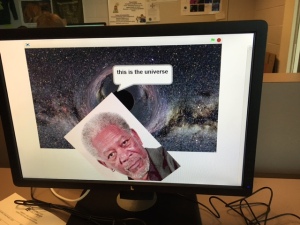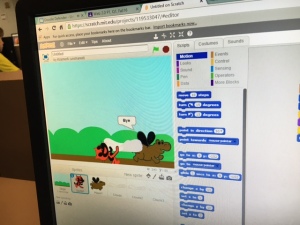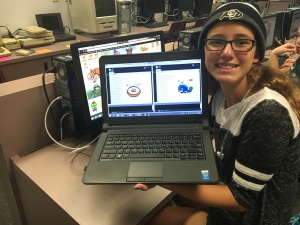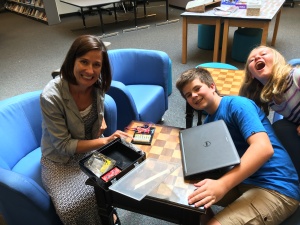The Realities of Bringing Virtual Reality (VR) to the Classroom
I wrote a blog for the Allen Distinguished Educators about my school’s experience starting a VR program in a middle school.
Realities of Bringing VR to the Classroom: ADE Blog
I have found quite a few articles lately about how VR can be helpful and life-changing for those that use it. VR can change your behavior and decision-making. VR can ease the pain of hospital patients, including children with sickle-cell disease as well as burn victims and other patients in pain. I think these ideas will really appeal to kids and empower them to think about what they could create in VR that involves the engineering process.
We’re excited for this program to gain traction this year!
Beginning of the year in CS and Electronics!
I’m now a couple of weeks into the 2016-2017 school year, and I really think things are off to a good start. This year marks a bittersweet milestone for me. This will be my ninth year teaching. I was a software engineer for nine years. After this year, I’ll have been teaching longer than I was an engineer. I guess this is my real job now!
I have three regular-length classes I teach this year, and they’re pretty much the same as last semester: Web 2.0 (our required quarter-long 6th grade tech class), Computer Science Explorations, and Electronics (both of these are semester-long electives for 7th and 8th graders).
I’ll also teach a couple of enrichment classes, for a shorter time and for no grades. I’ll blog about those once they get started!
In Web 2.0, I start the semester right away by introducing Scratch. It provides much more than just coding at the beginning. Students learn about data privacy as we talk about creating a login and password, and facilitate the discussion with their parents so they can get their accounts confirmed. We go over the Scratch community guidelines and talk about what it means to be a good internet citizen.
We dive into coding by exploring the “motion” and “looks” blocks and having students write a story. Sixth graders have a funny and strange sense of humor and I always get quirky programs from them, including things like farting, flying hippos and a purple Morgan Freeman in front of a black hole.

A sixth-grader’s imagination, in Scratch.

“Did you code a farting hippo?” “Yes I did!”
As we get into more challenging aspects of coding, we’ll continue to spiral back to the community guidelines, and we’ll learn about proper commenting, remixing, reusing and giving credit.
For the Computer Science Exploration class, we’re starting with coding right away in Processing. After doing some basic lessons on the coordinate plane, we learn about shape and color commands, and the students have to plan and create a free-draw program. I’ve blogged about this assignment before and enjoyed it this time around as well. Here’s some of the work from the kids.

Pixel art in Processing.

This student imagined a solar system model in Processing.
And in Electronics, my teaching partner, Tracey Winey, and I decided to start the semester with circuits and Arduino, and then in the second quarter we will explore the engineering design process with sustainable lights in Engineering Brightness. I love our Arduino program and the kids have so much fun with it. So far they’ve all been able to make multiple lights blink and they are just so happy when they make it all work. Coding is fun, but coding when you’re interacting with something in the real world is extremely rewarding – we are having literal light-bulb moments.
The Allen Distinguished Educator program and LearnBig worked with us to develop a DIY guide on the Arduino light-up music boxes, and we actually had our kids use the professional video to work on their first project. They enjoyed it and said the videos were very helpful.

Students show Mrs. Winey their blinking lights.
We asked the students to write reflections on Google Classroom about the blinking-light activity and their comments were gushing with positivity.
“i really was confused at first but now i get it and it is very fun!”
“I learned how to code, because I didn’t know how to code before. I really liked just the learning aspect of it because I have always wanted to code and I finally learned how to.”
“I learned how to use Arduino. I liked that I actually can make this board light up. it just felt nice.”
“I learned that it really isn’t that hard to program and arduino, and I really liked this! I just know I am going to have a lot of fun with these! Thank you so much for the opportunity!”
“I learned that this is a awesome class and that there was a lot of cool and hard steps to get to where i am i would have to say that i dont just like but love this class”
Wow, so many feels! I love being able to come back to those later in the year and reminding the students how far they’ve come and what they have learned!
As a final note, the number of girls taking CS and Electronics has slowly crept upward, although the numbers aren’t what I hoped they would be, and they probably never will be as long as learning computer programming / computing is considered optional. I have 4 girls in Electronics, and 12 total in my two sections of CS. It’s better than my first year when I would have one girl and 30 boys in a programming class, but we continue to be part of the problem when it comes to inequitable access to learning programming. The ability to program a computer won’t get less important as these kids graduate, and I wish for all of them to be able to participate in the world as inventors and creators.
I had my CS students do a little activity about their perception of programmers, and I’ll blog about that next time!
Recent Comments